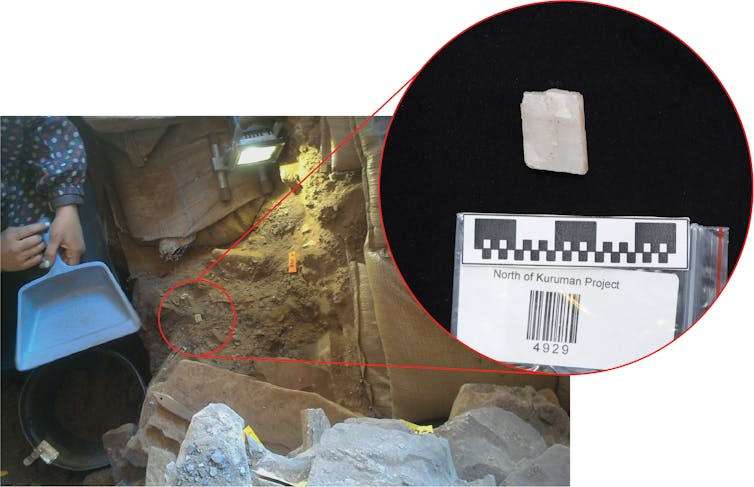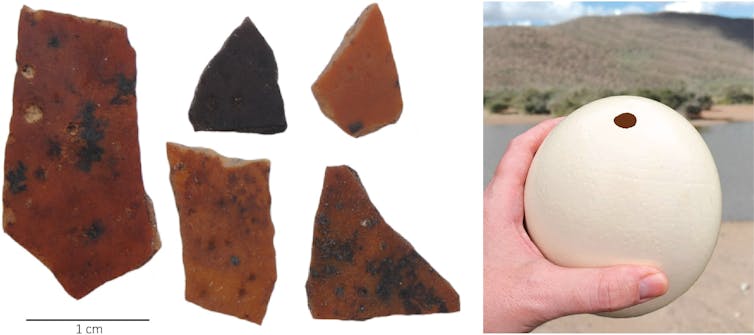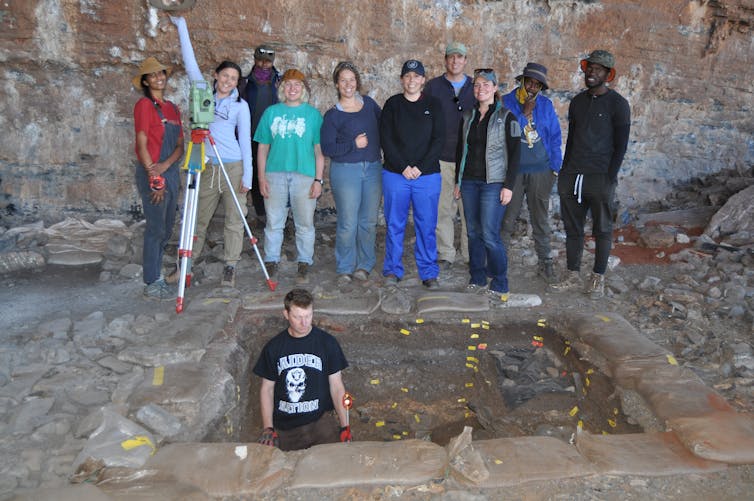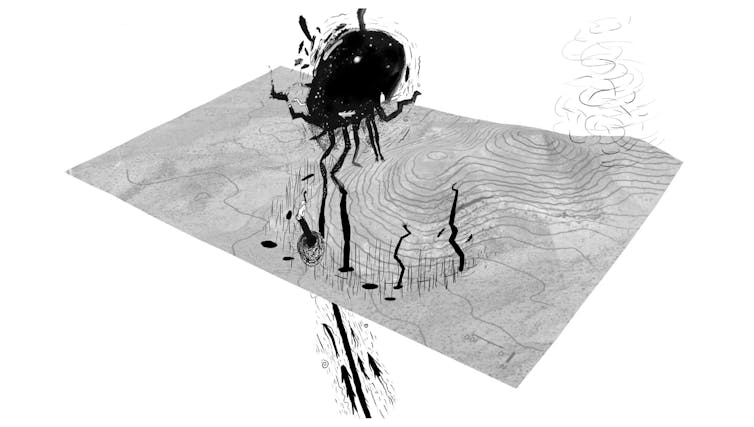
Jayne Wilkins, Griffith University and Sechaba Maape, University of the Witwatersrand
A rockshelter in South Africa’s Kalahari documents the innovative behaviours of early humans who lived there 105,000 years ago. We report the new evidence today in Nature.
The rockshelter site is at Ga-Mohana Hill — a striking feature that stands proudly above an expansive savanna landscape.
Many residents of nearby towns consider Ga-Mohana a spiritual place, linked to stories of a great water snake. Some community members use the area for prayer and ritual. The hill is associated with mystery, fear and secrecy.
Now, our findings reveal how important this place was even 105,000 years ago, documenting a long history of its spiritual significance. Our research also challenges a dominant narrative that the Kalahari region is peripheral in debates on the origins of humans.
We know our species, Homo sapiens, first emerged in Africa. Evidence for the complex behaviours that define us has mostly been found at coastal sites in South Africa, supporting the idea that our origins were linked to coastal resources.
This view now requires revision.

A crystal-clear finding
We found 22 white and well-formed calcite crystals brought to the site 105,000 years ago. We determined this using a method called “optically stimulated luminescence”, which dates sediments the crystals were excavated from.
Our analysis indicates the crystals were not introduced into the deposits via natural processes, but rather represent a small cache of deliberately collected objects.
Crystals found across the planet and from several time periods have previously been linked to humans’ spiritual belief and ritual. This includes in southern Africa.
People at coastal sites similarity started to collect non-food seashells around the same time (but not earlier) — perhaps for similar reasons.

Egg-citing technology
Ostrich eggshells can make excellent water storage containers and were used as such in southern Africa during the Pleistocene and Holocene. At coastal sites, the earliest evidence for this technology dates back about 105,000 years.
At Ga-Mohana Hill, we found ostrich eggshell fragments that show all the signs of being human-collected, based on their strong association with artefacts (including animal bones that are cut-marked from being butchered), and evidence of having been burned. These fragments may be the remains of early containers.

This suggests early humans in the Kalahari were no less innovative than those living on the coast.
A global effort
International and interdisciplinary collaboration makes for the best research and our paper’s authorship includes researchers from eight institutions across Australia, South Africa, Canada, Austria and the UK.
Local South African collaborators had an especially crucial role. For example, Robyn Pickering, Jessica von der Meden and Wendy Khumalo at the University of Cape Town provided important palaeoenvironmental context for the archaeology.
By dating tufa deposits around Ga-Mohana Hill, they showed water was more abundant 105,000 years ago when early humans were using the rockshelter.

Noga ya metsi
Many who visit Ga-Mohana Hill today for ritual practice see it as part of a network of places linked to the Great Water Snake (Noga ya metsi), a capricious and shape-shifting being. Many of these spiritual places are also associated with water.
Places such as Ga-Mohana Hill and their associated stories remain some of the most enduring intangible cultural artefacts from the past, linking modern indigenous South Africans to earlier communities.
These enduring beliefs establish an important sense of orientation in a country that has been spatially disorientated by colonial disruption.

Respectful research benefits all
Those who visit the site today for ritual purposes rely on its association with fear to launch them into their desired ritual states. The site’s remoteness greatly contributes to this.
Recognising this significance, we’ve been adjusting our project methods to not undermine the practices held there. For example, following each excavation season, the areas we work from are completely back-filled and covered with sediment.
In this way, we can carefully recover our sections later, but leave almost no visible trace of our work. We haven’t erected any signage or structures, or otherwise left any significant permanent modifications.
Community engagement continues as we consider ways to integrate the cultural and archaeological values of Ga-Mohana Hill. We are working to further develop an approach that has a positive impact on local communities, while also reflecting on what these communities teach us — particularly regarding respect and ritual.
From an archaeological perspective, we believe this approach will help ensure Ga-Mohana Hill can continue to offer new and valuable insights into the evolution of Homo sapiens in the Kalahari. https://www.youtube.com/embed/RKYo1XiyVWU?wmode=transparent&start=0 Jayne Wilkins, ARC DECRA Research Fellow at Griffith University, summarising the significance of the finds at Ga-Mohana Hill North Rockshelter.
Jayne Wilkins, ARC DECRA Research Fellow, Griffith University and Sechaba Maape, Senior Lecturer, University of the Witwatersrand
This article is republished from The Conversation under a Creative Commons license. Read the original article.
